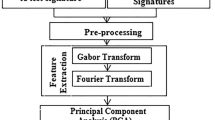Abstract
An overview is presented of how to use statistical methods for processing reference images in the formation of an authentication procedure using a handwritten signature.

Similar content being viewed by others
REFERENCES
Shub, D.A., A model for the process of handwriting creating, Tr. Inst. Sist. Anal. Ross. Akad. Nauk, 2009, vol. 42, no. 1, pp. 264–270.
Shub, D.A., Technology for obtaining a sequence of equal samples from a sequence of unequal samples in the analysis of handwritten text, Naukoemkie Tekhnol., 2009, vol. 10, no. 8, pp. 37–42.
Andrianova, E.G. and Shub, D.A., Improving the efficiency and security of distance learning through the use of modern handwriting analysis tools, Trudy XVI -go Mezhdunarodnogo Simpoziuma “Novye tekhnologii v obrazovanii, nauke i ekonomike” (Proc. XVIth International Symposium New Technologies in Education, Science and Economics), Moscow, 2007, pp. 128–131.
Sorokin, I.A., Compensation of distortions caused by instability of the slope of the signature in biometric authentication systems, Bezopasnost’ informatsionnykh tekhnologii. Trudy nauchno-tekhnicheskoi konferentsii (Information Technology Security. Proceedings of the Scientific and Technical Conference), Pensa, 2002, vol. 3, pp. 87–90.
Sorokin, I.A. and Olenin, Yu.A., Analysis of the trajectory of handwriting in biometric personal identification, Sovrem. Tekhnol. Bezop., 2003, no. 3, pp. 12–17.
Lozhnikov, P.S., Using the network of multidimensional Bayesian functionals for the neural network transformation of a personal handwritten signature into a secret key of their electronic signature, Trudy Mezhvuzovskoi nauchno-prakticheskoi konferentsii “Aktual’nye problemy obespecheniya informatsionnoi bezopasnosti”, 2017 (Proc. Interuniversity Scientific and Practical Conference Current Problems of Information Security), Samara, 2007, pp. 124–128.
Lozhnikov, P.S., Sulavko, A.E., Eremenko, A.V., and Volkov, D.A., Experimental assessment of the reliability of signature verification by networks of quadratic forms, fuzzy extractors, and perceptrons, Inf.-Upr. Sist., 2016, no. 5, pp. 73–85.
Los’, V.P. and Tyshuk, E.D., Constructing a user authentication system based on the preliminary formation of handwritten texts, Tezisy doklada. Metody i tekhnicheskie sredstva obespecheniya bezopasnosti informatsii: Materialy 26-i nauchno-tekhnicheskoi konferentsii 26–29 iyunya 2017 goda (Report Theses. Methods and Technical Means for Ensuring Information Security: Proc. 26th Scientific and Technical Conference on June 26–29, 2017), St. Petersburg, 2017, pp. 39–41.
Gruzman, I.S., Kirichuk, V.S., Kosykh, V.P., Peretyagin, G.I., and Spektor, A.A., Tsifrovaya obrabotka izobrazhenii v informatsionnykh sistemakh (Digital Image Processing in Information Systems), Novosibirsk: Novosib. Gos. Tekh. Univ., 2000.
Lozhnikov, P.S., Sulavko, A.E., and Samotuga, A.E., A model for protection of hybrid documents based on handwritten signatures of their owners, taking into account the psycho-physiological state of the signatories, Vopr. Zashch. Inf., 2016, no. 4, pp. 47–59.
Sulavko, A.E., Eremenko, A.V., Zhumazhanova, S.S., and Buraya, E.V., Generation of key sequences and verification of subjects based on a two-dimensional facial image, Avtom. Protsess. Upr., 2017, no. 1, pp. 58–66.
Sulavko, A.E., Levitskaya, E.A., Eremenko, A.V., and Samotuga, A.E., Identification of the psycho-physiological states of the signatories by the features of autograph reproduction, Inf.-Izmer. Upr. Sist., 2017, vol. 15, no. 3, pp. 40–48.
Sulavko, A.E., Eremenko, A.V., Tolkacheva, E.V., and Borisov, R.V., Complexing independent biometric features when recognizing subjects based on networks of quadratic forms, perceptrons, and chi-module measures, Inf.-Upr. Sist., 2017, no. 1, pp. 50–62.
Lozhnikov, P.S., Sulavko, A.E., Buraya, E.V., and Pisarenko, V.Yu., Authentication of computer users based on keyboard handwriting and facial features, Vopr. Kiberbezop., 2017, no. 3, pp. 24–34.
Los’, V.P., Problem issues of education development in the field of information security, Vestn. MGTU MIREA, 2015, no. 3, pp. 9–15.
Dubov, S.S. and Mesengiser, Ya.Ya., On the electronic signature and its prospects in the digital economy, Ross. Tekhnol. Zh., 2018, no. 5, pp. 5–14.
Zegzhda, D.P., Moskvin, D.A., and Bosov, Yu.O., Estimation of the complexity of solving the problem of face recognition using the principles of fractal image compression, Probl. Inf. Bezop., Komp’yut. Sist., 2012, no. 2, pp. 86–90.
Mizyukin, A.V. and Moskvin D.A., Estimation of the complexity of solving the problem of face recognition using the principles of fractal image compression, Probl. Inf. Bezop., Komp’yut. Sist., 2013, no. 3, pp. 27–39.
Moskvin, D.A. and Gluhov, V.V., Using principles of fractal image compression for complexity estimation of the face recognition problem, Nonlinear Phenom. Complex Syst. (Dordrecht, Neth.), 2014, vol. 17, no. 3, pp. 231–241.
Author information
Authors and Affiliations
Corresponding authors
Additional information
Translated by G. Dedkov
About this article
Cite this article
Los’, V.P., Ross, G.V. & Tyshuk, E.D. Use of Statistical Processing of Reference Images in Biometric Authentication Systems. Aut. Control Comp. Sci. 52, 1138–1143 (2018). https://doi.org/10.3103/S0146411618080382
Received:
Published:
Issue Date:
DOI: https://doi.org/10.3103/S0146411618080382




